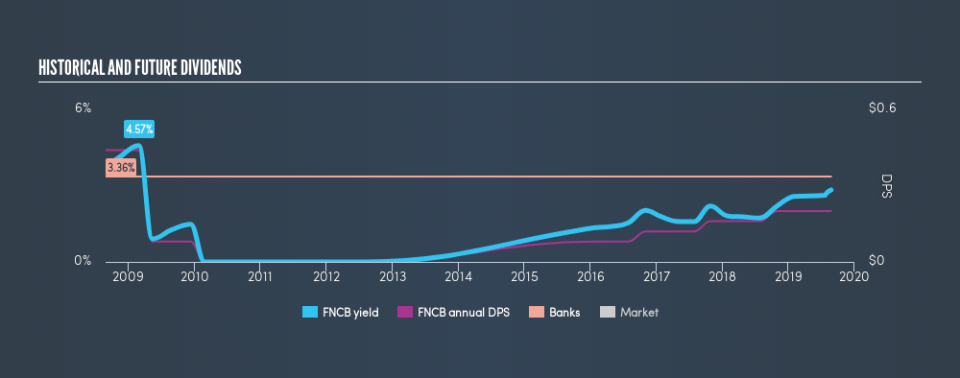There's A Lot To Like About FNCB Bancorp, Inc.'s (NASDAQ:FNCB) Upcoming 0.7% Dividend

FNCB Bancorp, Inc. (NASDAQ:FNCB) is about to trade ex-dividend in the next 4 days. You will need to purchase shares before the 30th of August to receive the dividend, which will be paid on the 16th of September.
FNCB Bancorp's next dividend payment will be US$0.05 per share, on the back of last year when the company paid a total of US$0.20 to shareholders. Based on the last year's worth of payments, FNCB Bancorp has a trailing yield of 2.8% on the current stock price of $7.06. We love seeing companies pay a dividend, but it's also important to be sure that laying the golden eggs isn't going to kill our golden goose! As a result, readers should always check whether FNCB Bancorp has been able to grow its dividends, or if the dividend might be cut.
Check out our latest analysis for FNCB Bancorp
If a company pays out more in dividends than it earned, then the dividend might become unsustainable - hardly an ideal situation. FNCB Bancorp paid out just 24% of its profit last year, which we think is conservatively low and leaves plenty of margin for unexpected circumstances.
Companies that pay out less in dividends than they earn in profits generally have more sustainable dividends. The lower the payout ratio, the more wiggle room the business has before it could be forced to cut the dividend.
Click here to see how much of its profit FNCB Bancorp paid out over the last 12 months.
Have Earnings And Dividends Been Growing?
Companies with consistently growing earnings per share generally make the best dividend stocks, as they usually find it easier to grow dividends per share. If business enters a downturn and the dividend is cut, the company could see its value fall precipitously. For this reason, we're glad to see FNCB Bancorp's earnings per share have risen 15% per annum over the last five years.
We'd also point out that FNCB Bancorp issued a meaningful number of new shares in the past year. It's hard to grow dividends per share when a company keeps creating new shares.
Many investors will assess a company's dividend performance by evaluating how much the dividend payments have changed over time. FNCB Bancorp's dividend payments per share have declined at 7.6% per year on average over the past 10 years, which is uninspiring. It's unusual to see earnings per share increasing at the same time as dividends per share have been in decline. We'd hope it's because the company is reinvesting heavily in its business, but it could also suggest business is lumpy.
Final Takeaway
From a dividend perspective, should investors buy or avoid FNCB Bancorp? When companies are growing rapidly and retaining a majority of the profits within the business, it's usually a sign that reinvesting earnings creates more value than paying dividends to shareholders. This strategy can add significant value to shareholders over the long term - as long as it's done without issuing too many new shares. Overall, FNCB Bancorp looks like a promising dividend stock in this analysis, and we think it would be worth investigating further.
Want to learn more about FNCB Bancorp? Here's a visualisation of its historical rate of revenue and earnings growth.
We wouldn't recommend just buying the first dividend stock you see, though. Here's a list of interesting dividend stocks with a greater than 2% yield and an upcoming dividend.
We aim to bring you long-term focused research analysis driven by fundamental data. Note that our analysis may not factor in the latest price-sensitive company announcements or qualitative material.
If you spot an error that warrants correction, please contact the editor at editorial-team@simplywallst.com. This article by Simply Wall St is general in nature. It does not constitute a recommendation to buy or sell any stock, and does not take account of your objectives, or your financial situation. Simply Wall St has no position in the stocks mentioned. Thank you for reading.

